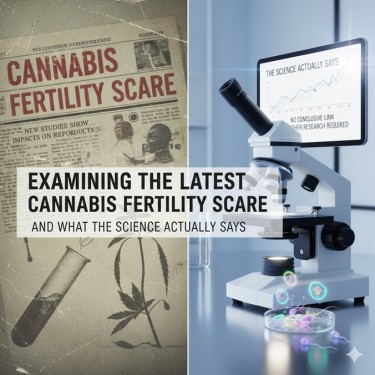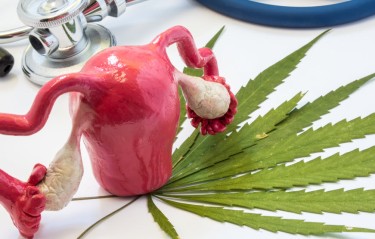
Right here we go once more. Simply whenever you assume we have moved previous the period of sensationalized hashish analysis designed to terrify the general public, alongside comes one other research that is being trumpeted as proof that marijuana is attacking our reproductive methods. CNN’s headline screams “Marijuana might trigger chromosomal defects in human egg cells,” and abruptly social media is flooded with warnings about hashish destroying fertility and creating genetic monsters.
However earlier than all of us panic and flush our stashes down the bathroom, let’s take a deep breath and look at what this research really discovered – and extra importantly, what it did not discover.
The analysis, printed in Nature Communications, checked out over 1,000 ovarian fluid samples from sufferers present process infertility remedy and located some associations between THC ranges and adjustments in egg maturation. The researchers are cautious to notice that their research “can solely present an affiliation and never a direct trigger and impact,” however by some means that essential caveat will get misplaced within the media frenzy that follows.
This sample ought to sound acquainted to anybody who’s been following hashish analysis over the previous few many years. Examine finds correlation, media stories causation, public freaks out, and in the meantime the precise science will get buried below layers of hypothesis and fear-mongering. It is like a best hits compilation of marijuana ethical panic, up to date for the trendy period.
Do not get me flawed – reproductive well being is critical enterprise, and any potential dangers deserve cautious investigation. However we additionally have to strategy these findings with the identical scientific skepticism we might apply to every other analysis, particularly in relation to a plant that is been demonized for almost a century.
The irony is wealthy: we’re being instructed to fret about THC affecting fertility whereas tens of millions of individuals in international locations with excessive hashish use – like Jamaica – proceed having wholesome infants at regular charges. If hashish have been actually the fertility destroyer these research recommend, we might count on to see clear population-level proof of reproductive issues in locations the place hashish use is widespread and culturally accepted.
So let’s dig into this newest research, separate the science from the sensationalism, and see if there’s really trigger for concern or if we’re witnessing one other case of correlation being dressed up as causation within the ongoing battle on weed.
Let’s begin with what the College of Toronto researchers really did, as a result of the methodology issues greater than the scary headlines. They analyzed ovarian fluid samples from ladies present process fertility therapies – already a specialised inhabitants that will not characterize typical hashish customers. They in contrast 62 sufferers who examined optimistic for THC with a management group and located some attention-grabbing associations.
The important thing findings have been that ladies with detectable THC ranges confirmed increased oocyte maturation charges and decrease numbers of embryos with the proper chromosome depend. Within the lab portion of the research, immature eggs uncovered to THC in petri dishes for twenty-four hours confirmed extra altered spindles – constructions that assist chromosomes separate correctly.
Now, this is the place we have to placed on our crucial considering caps. The researchers themselves acknowledge that is purely correlational information. Lead creator Cyntia Duval particularly warned in opposition to panic, stating, “This can be a speculation, and the worst factor I might need is for the general public to learn this and change into fearful.”
However there are a number of main limitations that ought to make us pause earlier than drawing any dramatic conclusions. First, this research solely checked out ladies already experiencing fertility issues extreme sufficient to require medical intervention. Utilizing this inhabitants to make claims about basic hashish use and fertility is like learning folks in cardiac intensive care models and concluding that respiration causes coronary heart assaults.
Second, the research could not management for numerous different variables that have an effect on fertility and egg high quality. What about stress ranges, different drug use, weight-reduction plan, environmental toxins, age, underlying well being situations, or socioeconomic components? Ladies in search of fertility remedy typically have advanced medical histories that would simply clarify the noticed variations.
Third, the lab portion of the research concerned exposing eggs to THC in synthetic situations that bear little resemblance to how hashish really impacts the human physique. Soaking eggs in THC in a petri dish for twenty-four hours is about as related to real-world hashish use as learning the results of drowning cells in alcohol and claiming it proves consuming water is harmful.
Maybe most significantly, the research discovered associations with THC ranges, however we do not know about utilization patterns, frequency, efficiency, or consumption strategies. Have been these occasional customers or each day customers? Did they use high-THC concentrates or low-potency flower? The research cannot inform us.
The researchers additionally acknowledge they could not set up causation – a vital limitation that appears to get misplaced in media protection. Correlation and causation usually are not the identical factor, and this distinction is key to scientific literacy. Simply because two issues happen collectively doesn’t suggest one causes the opposite.
Moreover, the scientific significance of the noticed adjustments stays unclear. Even when THC does have an effect on egg maturation ultimately, we do not know whether or not these adjustments really affect fertility outcomes or wholesome pregnancies. The research did not comply with these ladies to see if THC publicity correlated with precise reproductive issues.
What we now have is an attention-grabbing preliminary discovering that raises questions price investigating additional. What we do not have is proof that hashish use causes fertility issues or genetic defects – regardless of what the headlines may recommend.
This is the place the hashish fertility scare narrative runs into an enormous real-world downside: if THC actually wreaks havoc on human replica, we should always see clear proof of this in populations with excessive hashish use. But once we take a look at locations like Jamaica, the place hashish use is deeply embedded within the tradition and extensively accepted, we do not see the reproductive disaster that laboratory research appear to foretell.
Jamaica has one of many highest charges of hashish use on this planet, with cultural acceptance spanning generations. If hashish have been actually inflicting vital chromosomal defects, fertility issues, or beginning issues, we might count on to see Jamaica battling abnormally excessive charges of genetic issues, beginning defects, or fertility points. However that is merely not the case.
Jamaica’s beginning defect charges fall inside regular world ranges. Their fertility charges are literally above world averages. Jamaican ladies have been utilizing hashish throughout being pregnant for generations – typically as a standard treatment for morning illness – with out the population-level reproductive disasters that these research appear to recommend must be occurring.
This is not to say that hashish use throughout being pregnant is with out dangers or that it must be beneficial. However the disconnect between laboratory findings and real-world outcomes in high-use populations means that both the dangers are being overstated, or there are protecting components and adaptive mechanisms that laboratory research cannot seize.
Take into account the broader context of reproductive well being analysis. Beginning defects happen in roughly 2-4% of all births globally, no matter hashish use. Main chromosomal abnormalities like Down syndrome happen in about 0.1-0.2% of births. If hashish use have been considerably rising these charges, we might see clear epidemiological proof in populations with widespread use.
The Netherlands gives one other attention-grabbing case research. Hashish use is extensively tolerated and comparatively frequent, but Dutch reproductive well being statistics do not present the type of fertility or beginning defect epidemics that might be anticipated if these laboratory findings translated to real-world hurt.
This sample repeats throughout a number of populations with excessive hashish use. From sure areas of India the place hashish has been used medicinally for hundreds of years, to components of Africa with conventional hashish cultures, we merely do not see the reproductive well being crises that laboratory research appear to foretell.
This does not imply we should always ignore analysis or assume hashish is totally innocent. Nevertheless it does recommend that laboratory findings must be interpreted inside the context of real-world proof. When in vitro research contradict population-level information, we have to query whether or not the laboratory situations precisely replicate how hashish really impacts human well being.
There’s additionally the difficulty of publication bias and analysis funding priorities. Research that discover potential harms from hashish typically obtain extra consideration and funding than research that discover no results or useful results. This will create a skewed notion of threat that does not align with precise inhabitants well being information.
The scientific technique requires that we think about all obtainable proof, not simply the research that verify our preexisting beliefs or biases. When laboratory findings do not match real-world outcomes in high-use populations, that is not a cause to dismiss the analysis – it is a cause to dig deeper and ask higher questions on what’s actually happening.
The newest hashish fertility research represents each the promise and the pitfall of contemporary marijuana analysis. On one hand, we’re lastly getting subtle scientific evaluation of how hashish impacts human biology. However, we’re nonetheless battling sensationalized interpretations that always bear little resemblance to what the analysis really reveals.
The College of Toronto research raises official questions price investigating, but it surely would not present the definitive solutions that media protection suggests. Correlation is not causation, laboratory situations do not replicate real-world use, and small research of specialised populations cannot help sweeping claims about basic security or threat.
What’s most irritating is how this sample repeats: preliminary analysis will get amplified into scary headlines, nuanced scientific findings get decreased to simplistic warnings, and the precise complexity of hashish results on human well being will get misplaced within the noise.
We’d like higher hashish analysis – research that comply with real-world customers over time, analysis that accounts for the complete complexity of human biology and conduct, and investigations that think about each potential harms and advantages. However we additionally want higher science communication that does not flip each preliminary discovering into an ethical panic.
The true tragedy of sensationalized hashish analysis is not simply that it scares folks unnecessarily – it is that it undermines belief in official scientific inquiry. When each research will get hyped because the definitive phrase on hashish security, folks cease taking note of analysis altogether.
Hashish deserves the identical rigorous, balanced scientific scrutiny we apply to every other well being intervention. Which means acknowledging each potential dangers and advantages, recognizing the restrictions of preliminary analysis, and all the time holding real-world proof in perspective.



